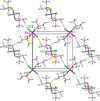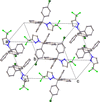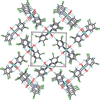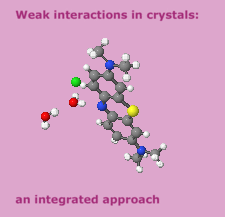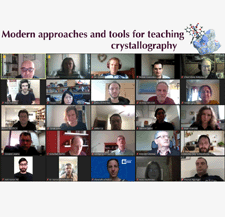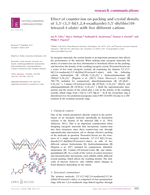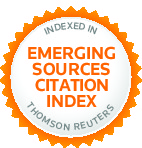issue contents
March 2025 issue
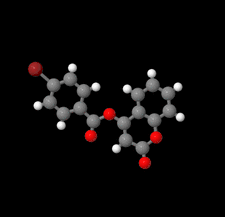
Cover illustration: Participants in the CNRS AFRAMED project, which trains young African researchers in X-ray diffraction, report the crystal structure of a coumarin derivative, 2-oxo-2H-chromen-4-yl 4-bromobenzoate, C16H9BrO4. The orthorhombic crystals (P212121) exhibit π-stacking interactions and a weak C—H⋯O hydrogen bond in the 3D architecture. See: Bationo, Kambo, Sorgho, Sombie, Thiam, Semde, Djande, Lecomte & Wenger (2025). Acta Cryst. E81 200–203.
research communications
Download citation


Download citation


Various compounds involving trialkylphosphane chalcogenides (or their derivatives) and palladium or platinum dihalides were structurally characterized and their intra- and intermolecular interactions and metrical parameters were analysed. General comments on the SFAC command are also included.
Download citation


Download citation


A new mebendazolium dihydrogen phosphate phosphoric acid solid compound was obtained. As expected, the mebendazolium cation and the dihydrogen phosphate anion assemble in the solid state in an R22(8) hydrogen-bond-driven supramolecular motif.
CCDC reference: 2381432
Download citation


Download citation


In the title compound, the dihedral angle between the chromen-2-one ring system and the bromobenzene ring is 10.29 (6)°. In the crystal, the molecules are connected through C—H⋯O hydrogen bonds and π–π stacking interactions.
CCDC reference: 2416578
Download citation


Download citation


The asymmetric unit of the title compound, {[Co(C12H6O6)(H2O)4]·2C3H7NO}n or {[Co(H2dondc)(H2O)4]·2DMF}n, comprises half of a CoII ion, half of a 1,5-dihydroxynaphthalene-2,6-dicarboxylate dianion (H2dondc2−), two water molecules and a dimethylformamide (DMF) molecule. The key feature of the structure is a three-dimensional hydrogen-bonding network that consists of one-dimensional (1D) coordination chains built up by CoO6 octahedra bridged by H2dondc2− ligands and interchain O–H⋯O hydrogen-bonding interactions.
CCDC reference: 2421049
Download citation


Download citation


The title molecule was studied by single-crystal X-ray analysis to determine its molecular structure and investigate the interactions present. Theoretical (obtained by DFT) and experimental parameters were compared. In addition, Hirshfeld surface analysis and molecular docking studies were performed for the title compound as a ligand and the SARS-Covid-2 (PDB ID:8BEC) protein, specifically the Omicron variant.
CCDC reference: 2421495
Download citation


Download citation


Both compounds crystallized from a saturated solution in THF by slow vapour diffusion of n-hexane in the monoclinic space group P21/c. While the two independent molecules in the asymmetric unit of 1,1′,1′′-[(2-iodoethoxy)methanetriyl]tribenzene show no close contacts to other molecules, in the structure of 1,1′,1′′-[(2-bromoethoxy)methanetriyl]tribenzene the molecules interact with each other by C—H⋯π contacts.
Download citation


Download citation


Methylation of the natural product macluraxanthone yielded its methoxy analog, which was characterized by a suite of spectroscopic and crystallographic techniques.
CCDC reference: 2421853
Download citation


Download citation


The title compound was produced by the reaction between 3,4-dicyanothiophene and 2-pyridylselenyl chloride and isolated as a salt that crystallizes in the triclinic space group P1. Notable features include strong chalcogen interactions (Se⋯Cl and Se⋯S), as revealed through Hirshfeld surface analysis, which also highlights significant contributions from N⋯H/H⋯N, C⋯H/H⋯C and H⋯H contacts in the crystal packing.
CCDC reference: 2300276
Download citation


Download citation


The crystal structures of five fluorinated diphenidine molecules obtained as their hydrochloride salts are reported.
Download citation


Download citation


The title pyrazole derivative, which exhibits multiple intermolecular non-covalent interactions, was synthesized by the reaction of 3-(trifluoromethyl)-1H-pyrazole with chloro(4-chlorophenyl)methylene)dibenzene in the presence of K2CO3 in tetrahydrofuran.
CCDC reference: 2422692
Download citation


Download citation


The crystal structure of the insecticide/acaricide etoxazole is presented along with a Hirshfeld surface analysis of intermolecular interactions present in the crystal structure.
CCDC reference: 2422554
Download citation


Download citation


Compounds 1 and 2 are similar coordination polymers of bibromide bridged chains of CuII ions with 3,5-disubstituted pyridine molecules in the axial sites. The chains lie parallel to the a axis and are linked into a tri-periodic network via non-classical hydrogen bonds.
Download citation


Download citation


The molecular and crystal structures of the coordination compound [Co(tsc)3]2[Co(cit)2](NO3)4·4H2O are reported. Fingerprint plots were generated to investigate various intermolecular interactions.
CCDC reference: 2364098
Download citation


Download citation


Charge-assisted chalcogen bonds with Se⋯Cl separations of 2.883 (2) and 3.030 (2) Å aggregate the title compound into a supramolecular dimer.
CCDC reference: 2424642
Download citation


Download citation


The title compound was synthesized by SN2 reaction of bromomethyl coumarin with 4,4-dimethylpiperidine-2,6-dione. Its crystal structure was determined and a Hirshfeld surface analysis was performed along with DFT, molecular docking and biological activity studies.
CCDC reference: 2425502
Download citation


Download citation


Br⋯O contacts between neighboring molecules are present in the crystal of the title compound. Its photophysical properties were estimated by solvatochromic method.
CCDC reference: 2384236

 journal menu
journal menu











